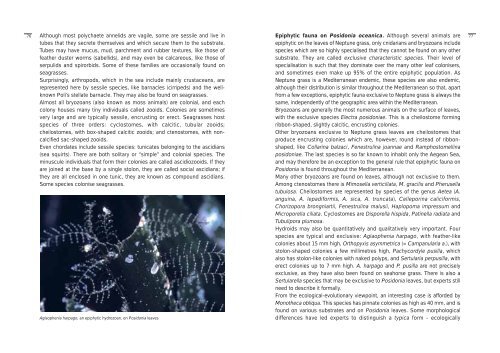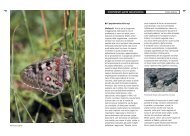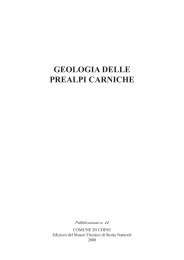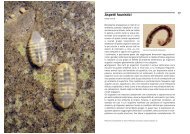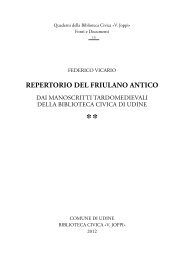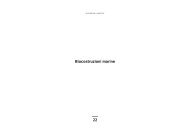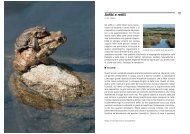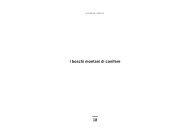Fauna: invertebrates - Udine Cultura
Fauna: invertebrates - Udine Cultura
Fauna: invertebrates - Udine Cultura
Create successful ePaper yourself
Turn your PDF publications into a flip-book with our unique Google optimized e-Paper software.
76<br />
Although most polychaete annelids are vagile, some are sessile and live in<br />
tubes that they secrete themselves and which secure them to the substrate.<br />
Tubes may have mucus, mud, parchment and rubber textures, like those of<br />
feather duster worms (sabellids), and may even be calcareous, like those of<br />
serpulids and spirorbids. Some of these families are occasionally found on<br />
seagrasses.<br />
Surprisingly, arthropods, which in the sea include mainly crustaceans, are<br />
represented here by sessile species, like barnacles (cirripeds) and the wellknown<br />
Poli’s stellate barnacle. They may also be found on seagrasses.<br />
Almost all bryozoans (also known as moss animals) are colonial, and each<br />
colony houses many tiny individuals called zooids. Colonies are sometimes<br />
very large and are typically sessile, encrusting or erect. Seagrasses host<br />
species of three orders: cyclostomes, with calcitic, tubular zooids;<br />
cheilostomes, with box-shaped calcitic zooids; and ctenostomes, with noncalcified<br />
sac-shaped zooids.<br />
Even chordates include sessile species: tunicates belonging to the ascidians<br />
(sea squirts). There are both solitary or “simple” and colonial species. The<br />
minuscule individuals that form their colonies are called ascidiozooids. If they<br />
are joined at the base by a single stolon, they are called social ascidians; if<br />
they are all enclosed in one tunic, they are known as compound ascidians.<br />
Some species colonise seagrasses.<br />
Aglaophenia harpago, an epiphytic hydrozoan, on Posidonia leaves<br />
Epiphytic fauna on Posidonia oceanica. Although several animals are<br />
epiphytic on the leaves of Neptune grass, only cnidarians and bryozoans include<br />
species which are so highly specialised that they cannot be found on any other<br />
substrate. They are called exclusive characteristic species. Their level of<br />
specialisation is such that they dominate over the many other leaf colonisers,<br />
and sometimes even make up 95% of the entire epiphytic population. As<br />
Neptune grass is a Mediterranean endemic, these species are also endemic,<br />
although their distribution is similar throughout the Mediterranean so that, apart<br />
from a few exceptions, epiphytic fauna exclusive to Neptune grass is always the<br />
same, independently of the geographic area within the Mediterranean.<br />
Bryozoans are generally the most numerous animals on the surface of leaves,<br />
with the exclusive species Electra posidoniae. This is a cheilostome forming<br />
ribbon-shaped, slightly calcitic, encrusting colonies.<br />
Other bryozoans exclusive to Neptune grass leaves are cheilostomes that<br />
produce encrusting colonies which are, however, round instead of ribbonshaped,<br />
like Collarina balzaci, Fenestrulina joannae and Ramphostomellina<br />
posidoniae. The last species is so far known to inhabit only the Aegean Sea,<br />
and may therefore be an exception to the general rule that epiphytic fauna on<br />
Posidonia is found throughout the Mediterranean.<br />
Many other bryozoans are found on leaves, although not exclusive to them.<br />
Among ctenostomes there is Mimosella verticillata, M. gracilis and Pherusella<br />
tubulosa. Cheilostomes are represented by species of the genus Aetea (A.<br />
anguina, A. lepadiformis, A. sica, A. truncata), Celleporina caliciformis,<br />
Chorizopora brongniartii, Fenestrulina malusii, Haplopoma impressum and<br />
Microporella ciliata. Cyclostomes are Disporella hispida, Patinella radiata and<br />
Tubulipora plumosa.<br />
Hydroids may also be quantitatively and qualitatively very important. Four<br />
species are typical and exclusive: Aglaophenia harpago, with feather-like<br />
colonies about 15 mm high, Orthopyxis asymmetrica (= Campanularia a.), with<br />
stolon-shaped colonies a few millimetres high, Pachycordyle pusilla, which<br />
also has stolon-like colonies with naked polyps, and Sertularia perpusilla, with<br />
erect colonies up to 7 mm high. A. harpago and P. pusilla are not precisely<br />
exclusive, as they have also been found on seahorse grass. There is also a<br />
Sertularella species that may be exclusive to Posidonia leaves, but experts still<br />
need to describe it formally.<br />
From the ecological-evolutionary viewpoint, an interesting case is afforded by<br />
Monotheca obliqua. This species has pinnate colonies as high as 40 mm, and is<br />
found on various substrates and on Posidonia leaves. Some morphological<br />
differences have led experts to distinguish a typica form - ecologically<br />
77


